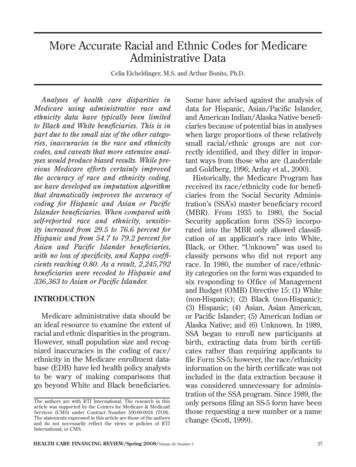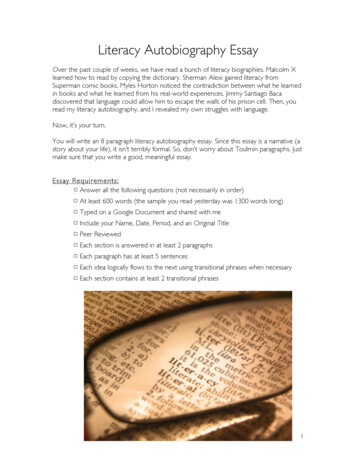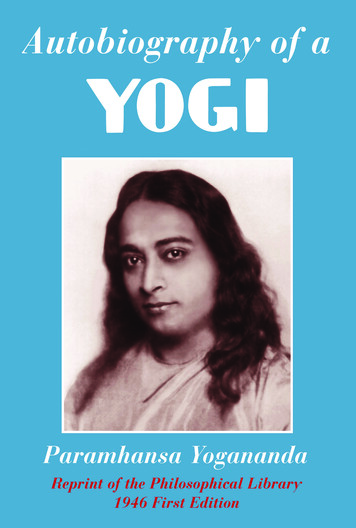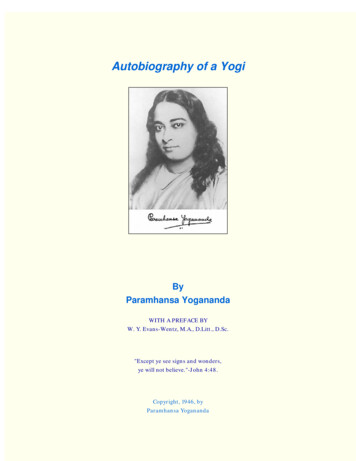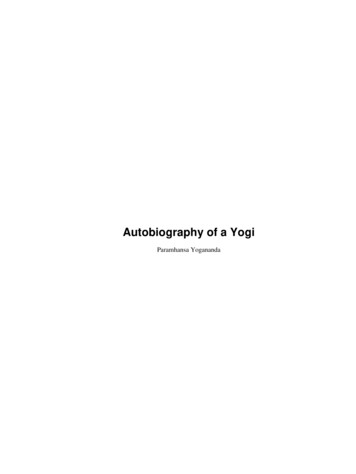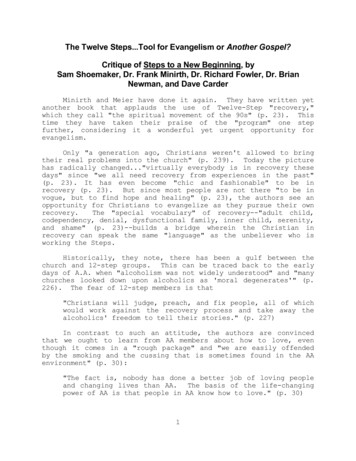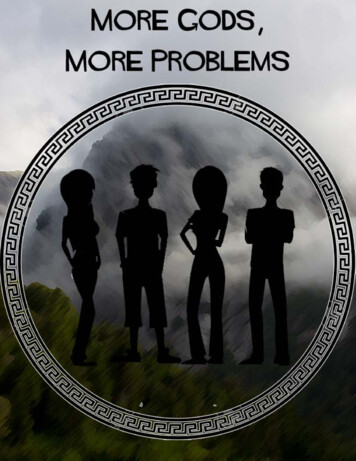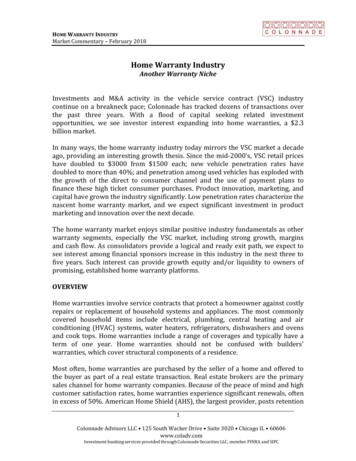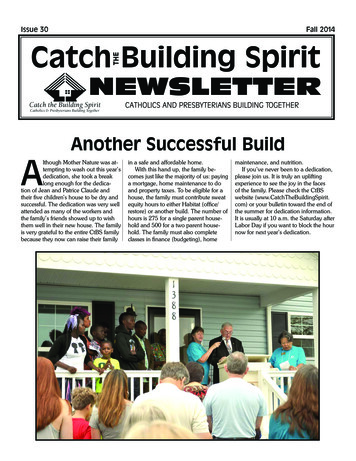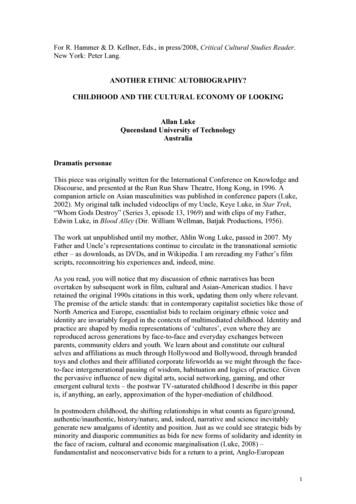
Transcription
For R. Hammer & D. Kellner, Eds., in press/2008, Critical Cultural Studies Reader.New York: Peter Lang.ANOTHER ETHNIC AUTOBIOGRAPHY?CHILDHOOD AND THE CULTURAL ECONOMY OF LOOKINGAllan LukeQueensland University of TechnologyAustraliaDramatis personaeThis piece was originally written for the International Conference on Knowledge andDiscourse, and presented at the Run Run Shaw Theatre, Hong Kong, in 1996. Acompanion article on Asian masculinities was published in conference papers (Luke,2002). My original talk included videoclips of my Uncle, Keye Luke, in Star Trek,“Whom Gods Destroy” (Series 3, episode 13, 1969) and with clips of my Father,Edwin Luke, in Blood Alley (Dir. William Wellman, Batjak Productions, 1956).The work sat unpublished until my mother, Ahlin Wong Luke, passed in 2007. MyFather and Uncle’s representations continue to circulate in the transnational semioticether – as downloads, as DVDs, and in Wikipedia. I am rereading my Father’s filmscripts, reconnoitring his experiences and, indeed, mine.As you read, you will notice that my discussion of ethnic narratives has beenovertaken by subsequent work in film, cultural and Asian-American studies. I haveretained the original 1990s citations in this work, updating them only where relevant.The premise of the article stands: that in contemporary capitalist societies like those ofNorth America and Europe, essentialist bids to reclaim originary ethnic voice andidentity are invariably forged in the contexts of multimediated childhood. Identity andpractice are shaped by media representations of ‘cultures’, even where they arereproduced across generations by face-to-face and everyday exchanges betweenparents, community elders and youth. We learn about and constitute our culturalselves and affiliations as much through Hollywood and Bollywood, through brandedtoys and clothes and their affiliated corporate lifeworlds as we might through the faceto-face intergenerational passing of wisdom, habituation and logics of practice. Giventhe pervasive influence of new digital arts, social networking, gaming, and otheremergent cultural texts – the postwar TV-saturated childhood I describe in this paperis, if anything, an early, approximation of the hyper-mediation of childhood.In postmodern childhood, the shifting relationships in what counts as figure/ground,authentic/inauthentic, history/nature, and, indeed, narrative and science inevitablygenerate new amalgams of identity and position. Just as we could see strategic bids byminority and diasporic communities as bids for new forms of solidarity and identity inthe face of racism, cultural and economic marginalisation (Luke, 2008) –fundamentalist and neoconservative bids for a return to a print, Anglo-European1
‘basics’ and canonical knowledges are a nostalgic essentialism built around a mythicprint, Anglo-American childhood lost (Luke & Luke, 2001).In current conditions, Aristotelian concepts of mimesis, romantic concepts ofauthenticity, pramatist notions of experience, and, indeed, revolutionary construals ofvoice are partial and unstable. His views about the possibilities of political solidarityand action aside, Baudrillard’s (1995) concept of the simulacrum marks a key turningpoint in Western theories of representation, art, culture and semiotics. My aim in thispaper was to turn the concept of simulation to questions of childhood and culturalidentity, albeit through the lens of my own family’s idiosyncratic history. My effortsalso are an attempt to reclaim that history – insofar as Keye Luke’s work as an actorhas been the object of considerable critical analysis and speculation.1 Because of hisnotoriety as Charlie Chan’s “Number One Son”, he has been viewed widely as anembodiment of the stereotypical subservient Chinese.My father, Edwin Luke (1911-1986) and his elder brother, Keye Luke (1904-1991)were children of Cantonese migrants to Seattle. My grandfather died when they wereyoung of a violent “incident”, the object of speculation in Chinatown talk. The familyworked its way through the next decades in Seattle, with everybody working to makeends meet. Part of our famly’s story is archived in Seattle’s Wing Luke Museum. Thefamily’s folk narrative about their involvement in the movies goes something likethis: Keye Luke was an excellent student and developed into a fine pen and inkartist/illustrator, modelling his drawing on that of Aubrey Beardsley. His publishedwork includes a limited edition of the Rubyiat of Omar Kyam. His first involvementwith cinema was as a publicity/poster artist for one of the local theatres. In Seattle orperhaps Los Angeles, the story goes, he met industry contacts looking for Chineseactors with excellent spoken English diction – which his was. His work in films,typical of non-white actors in the period, was an historical accident. He moved to LosAngeles in the 1930s to begin – followed shortly thereafter by my father, Edwin Luke.Keye signed as the first Asian contract player at MGM in the 1930s. Following his1934 debut in The Painted Veil, he was cast as the original number one son in theCharlie Chan series with Werner Oland – who became a friend and mentor. Hesubsequently moved on to a half-century career that included over two hundred ofwartime and postwar movies as Asian soldier, scholar, politician, houseboy andservant. His corpus also included Broadway and off-Broadway leading roles inseveral Rogers and Hammerstein musicals like Flower Drum Song. He was a regularon 1950s and 60s television series, with featured roles in Anna and the King and, mostnotably, as Master Po in Kung Fu and guest slots in everything from Gunsmoke toStar Trek to Trapper John MD. In his later years, he had small but notable roles inSpielberg’s Gremlins. His final appearance was in Woody Allen’s Alice.My Father, Edwin S. Luke took a different route. He left Seattle in the 1930s with ajournalism degree from the University of Washington. He landed a role in the JadeMask (1945) as the number 4 son of Charlie Chan (Sydney Toler) and a feature role in1For an overview, see http://en.wikipedia.org/wiki/Keye Luke. There are numerousCharlie Chan websites describing both his work and noting Edwin Luke’s role asnumber 4 son. Some are laudatory, others critical, and yet others replicate withoutirony the orientalism and stereotypes of the original films.2
the Paramount production of Tokyo Rose (1945) His principal work was as a featuredplayer in movies Bloody Alley (1955), and over 30 minor parts in TV and cinema.From the contracts left behind in his papers, he’s probably still owed residuals. Theacting didn’t pay the bills and by the early 1950s, parts for Asian actors had dried upconsiderably – with a visible shift from the portrayal of evil Japanese to evilCommunist Chinese. He worked delivering newspapers, as an insurance salesman,and proofreader to make ends meet. He was the first Chinese member of theCalifornia printers union, and went to work in the 1940s in the press room of theHollywood Reporter. A typographer and linotyper by trade, he was a fine writer andeditor. Around the time of the passage of the Civil Rights Act of 1964, he began atwenty five career as a social worker in Los Angeles, working closely with the Latinocommunity in Tijunga. His life and work informed my writing, politics and worldview. He and my Uncle told my sisters and me that we should never be actors.Ethnic affiliations and visibilityOne of the powerful knowledge and political effects of postcolonial and feministintellectual work has been to open a space for other voices in the public spheres ofpopular and academic writing. But in attributing this ‘opening’ to minority voices tofeminisms and postcolonialism, it would be a mistake to overlook the long histories ofunderground literature that extend back to historical slave narratives, revolutionaryliterature, and the work of women poets and novelists, much of which was censoredor suppressed from mainstream selective traditions of literature and curriculum untilthe last two decades. At the same time, it would be naive to that the emergence of newnarratives of ethnic identity are somehow the results of new found political power,literary quality or suppressed genius. There are of course powerful politicaleconomies at work in the production and popularisation of women’s, ethnic migrant,diaporic and postcolonial films and literature -- in Sydney, Shanghai, Hollywood,New York, Hong Kong and elsewhere. Ethnic narratives - whether those ofHollywood’s or Hong Kong’s China - have become increasingly marketable, movingfrom the “foreign films” category into the mainstream.This chapter is nominally about the construction of ethnic selves and narratives,offering an analysis of ways of portraying and narrating culturally different lifehistories of visible minority groups in mainstream, white-dominated cultures. Itproceeds in two moves. First, I provide an overview of two genres that I provisionallyterm ‘ethnic narratives’ -- narratives of liberation and narratives of displacement -discussing their assumptions about essence, origins, authenticity, and, the place andsignificance of pedagogy in the formation of the self. Here I look briefly andselectively at the work of Latino, Asian-American and Asian-Australian writers.I then present an alternative story, a narrative of growing up ethnic in postmodernculture. This is a more complex and complicated process than either the common‘return to the origins’ or ‘between two worlds’ metaphors explain. My story begins tospeak of ethnic childhood as simulacrum (Baudrillard, 1995), of identity formation asa form of channel and web surfing, of childhood as a task of holding mirrors up to themirrors of popular cultural texts. Along the way, I offer one such narrative, dealing atlength with my family’s experiences of the construction and portrayal of AsianAmericans in movies and television. So the watching and participating in theHollywoodisation of images of the Asian is what this paper is really about3
(Hamamoto, 1994). This is, hopefully, Orientalism and Occidentalism intechnicolour, Panavision and black and white. Or, to give you a sense of the its finalresting place, the subtitle should be: You thought you were constructing us as theOther, when we were busy watching and laughing at how you construct yourselvesand us.2I will use the shorthand terminology here of ‘visible minorities’ to refer to those of uswho are people of colour in White-dominant, so-called Western cultures like the US,Australia, Canada and the UK. I am aware of the difficult issues of definitionsurrounding cultural difference, visibility and race (Luke & Luke, 1999). Whether weuse the terms ‘ethnic’ or ‘racial’ or ‘cultural minority’ is bound to raiseepistemological and political problems of inclusivity, exclusivity and homogeneity.For the purposes of this narrative, I characterise postcolonial subjects as offspring ofcolonialisation, as those people of cultural and racial groups who have historicallybeen marginalised or made diasporic by large scale political and population shiftsaccompanying decolonisation. This marginalisation might have entailed centurieslong political and economic colonisation and domestic subjugation, systematicgenocide or forced relocation, as in the case of indigenous peoples, or migration as theresult of the growth or collapse of European or Asian empire. The processes ofmarginalisation typically involve racialising practices -- the discursive andinstitutional practices whereby people of visible difference are ascribed as an inferior,exterior, and negative Other, with curtailed or limited access to economic, politicaland human rights (Luke, 2008).There is of course considerable debate over the extent to which the desciptors used fordiasporic and ‘minority’ communities refer to homongeneous communities. We cantake categorisations of ethnic and cultural groups as descriptions of residual andemergent cultural affiliations defined in relation to White-dominant societies andinstitutions, and specific political economies. In the case of Asian-Americans, whohave some striking historical parallels with their counterpart Asian-Australians andAsian-Canadians, a range of definitional issues arise. First, the historical solidarityamong Asian-Americans is itself a discourse move, developed as a political strategyin the 1960s to bring together many disparate and historically autonomous groups,including Japanese-Americans, Chinese-Americans, Filipino-Americans and otherswho had been distinguished both by their own histories, and by successful divide andrule strategies like the relocation policies of World War II, discriminatory housing andeducational practices and citizenship legislation (cf. Kim, 1993). Second, the veryterm “Asian” and such partner terms as “Asia-Pacific” are increasingly used toestablish imaginary spaces that serve particular political and economic ends (Wilson& Dirlak, 1995; Luke & Ismail, 2007). Third, the degree to which such categories asAsian-American risk totalising the class, generational and place-bound demographicdiversity of any ethnic minority group raises serious issues -- as does reference to the2There may be a salutary lesson in this for scholars focusing on the colonising viewsof ‘Asia’ in Western literature, history and media. This work risks replicating,however intentionally, the imperial assumption that the Eurocentric gaze continues tomatter. Given the geopolitical and cultural shift of flows towards and from China andIndia, it may be strategically and critically more important to focus on how thesepeoples and places represent and position the ‘West’ (Louie, 2002).4
imaginary category of a ‘dominant Anglo/Australian culture’. But we’ve got to startsomewhere.On the other hand, to refer to Asians or, more specifically diasporic Chinese,Carribean migrants, African refugees and others as ‘ethnic groups’ comparable toother European ethnic groups, as has been the tre
Father and Uncle’s representations continue to circulate in the transnational semiotic ether – as downloads, as DVDs, and in Wikipedia. I am rereading my Father’s film scripts, reconnoitring his experiences and, indeed, mine. As you read, you will notice that my discussion of ethnic narratives has been overtaken by subsequent work in film, cultural and Asian-American studies. I have .
